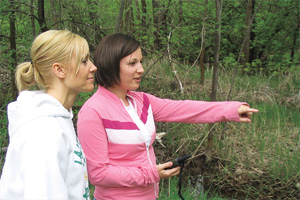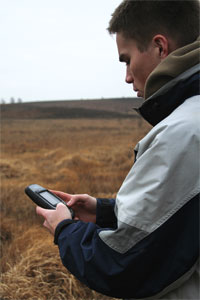Geocaching is a high-tech treasure hunting game played throughout the world by adventure seekers equipped with GPS devices. The basic idea is to locate hidden containers, called geocaches, outdoors and then share your experiences online. Geocaching is enjoyed by people from all age groups, with a strong sense of community  and support for the environment.
and support for the environment.
Getting started is easy, if you have the right equipment. A geocacher can place a geocache in the world, pinpoint its location using GPS technology and then share the geocache’s existence and location online. Anyone with a GPS unit can then try to locate the geocache.
There are many groups that participate world-wide in geocaching, and nonprofit organizations like Tread Lightly! provide reference materials to ensure the game is played safely, with minimal impact to the environment. When geocaching it’s important to make a realistic plan and stick to it; familiarize yourself with restrictions in your area before you decide where to place a cache; and in addition to your GPS receiver — always carry extra batteries, a map and compass, and know how to use them.
 Avoid placing caches in sensitive habitats such as meadows, lakeshores, wetlands, caves and seasonal nesting or breeding areas. Avoid placing a cache or disturbing historical, archeological and paleontological sites.
Avoid placing caches in sensitive habitats such as meadows, lakeshores, wetlands, caves and seasonal nesting or breeding areas. Avoid placing a cache or disturbing historical, archeological and paleontological sites.
Avoid “spooking” livestock and wildlife you encounter during cache placement, and keep your distance.
Do your part by leaving the area better than you found it. Cache placers avoid burying the cache in the ground. It is the cache owner’s responsibility to maintain the cache and the surrounding area. If a cache’s area is impacted, confer with the land manager on how you will mitigate the impacts, and seek their advice as to whether to relocate the cache. Never place food items in a cache. Don’t modify the environment for any reason, even when hiding a cache.
For cache seekers, use maps to find a route that will minimize impacts. Note waypoints during your journey to assist you on your return trip. If you notice a path has started to wear in the vicinity of a cache, notify the  cache owner via e-mail. Practice “lift, look, replace” technique. If you lift a rock to look under it, replace it exactly as you found it. After you’ve finished searching for a cache, the area should look as though you were never there, or better than when you arrived.
cache owner via e-mail. Practice “lift, look, replace” technique. If you lift a rock to look under it, replace it exactly as you found it. After you’ve finished searching for a cache, the area should look as though you were never there, or better than when you arrived.
Minimize impacts left by others whenever possible. Carry a trash bag on your vehicle and pick up litter left by others. Pack out what you pack in. Practice minimizing impact by camping in established sites, 200 feet from water resources and trails. Observe proper sanitary waste disposal or pack your waste out. Following a trip, wash your gear and support vehicle to reduce the spread of invasive species.
By practicing these tips, you not only protect the outdoors while having fun, but you protect access to recreation opportunities for years to come.



